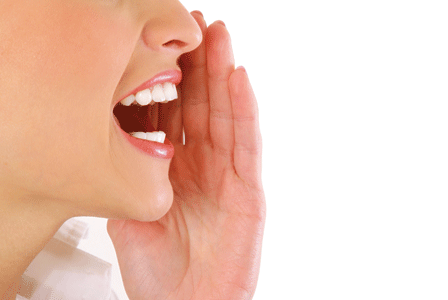
May is Speech and Hearing Awareness Month. Discover the causes and types of hearing loss and how to protect your hearing.
What would life be like if you were unable to hear your favourite song or your child’s first word? Would music exist were it not for the gift of hearing?
Helen Keller, a woman rendered blind and deaf from an early age, who—through sheer determination—learned to communicate using Braille wrote, “Blindness separates us from things, but deafness separates us from people.”
Helen Keller’s insight brilliantly highlights the important relationship between hearing and communication. Humans are social beings, and in a world full of sound, hearing is an essential sense.
Hearing, like other senses, provides an interface between the brain and the physical world. Our sense of hearing is a remarkable system enabling us to receive and interpret sound. All the senses work together in harmony to gather information about the world.
This information is processed by the brain to compose a lively scene of the world with all its many sights, sounds, smells, tastes, and textures. We often take our senses for granted, but it’s not until we become deficient in one (or more) of them, that we realize the impact this has on our lives.
Types and causes of hearing loss
| Signs of hearing loss
In adults:
In children:
|
The human ear has three parts: the outer, middle, and inner ear. This is known as the auditory pathway. Hearing loss occurs when there is disruption to structures anywhere along the auditory pathway. The site and cause of damage are used to describe the type of
hearing loss.
Outer/middle ear
For example, a problem with the outer and/or middle ear that interferes with the conduction of sound flow is known as a conductive hearing loss (CHL). In most cases, CHL is temporary and usually treatable.
Possible causes:
- excess wax in the outer ear
- fluid buildup in the middle ear, such as from an ear infection and perforation or other damage to the eardrum
- deformity, absence, or disease of the small bones in the middle ear
Inner ear
A hearing loss affecting the inner ear is called a sensorineural hearing loss (SNHL). This type of hearing impairment is often permanent. Statistically, 20 percent of those over the age of 65 and 40 percent of those over 75 have a significant hearing problem.
Possible causes:
- deterioration of the inner ear associated with the natural aging process known as presbyacusis
- hereditary factors
- overexposure to loud noise
- certain medications
- viral or bacterial infections
Combined
When CHL and SNHL are present together, the combination is described as a mixed hearing loss.
Hear today, gone tomorrow?
Hearing loss can go undetected for many years, especially if the underlying cause is advancing age, because the hearing deficit tends to develop slowly over time.
|
Noise exposure Aside from hearing loss, other adverse health effects thought to be linked to excessive noise exposure include:
|
A person may be unaware that their hearing is not as sharp as it once was, because they develop mechanisms to compensate for the reduced hearing acuity. For others, hearing loss may develop suddenly or progress quickly such that its effects are easily noticeable. (See sidebar for signs of hearing loss).
Hearing loss is one of the most common disorders present at birth. In fact, about one to three of every 1,000 babies born will have a hearing loss issue. The risk is even higher (one in 50) for babies who are admitted to a special care nursery.
Unlike adults, babies lack the cognitive skills to express if they are unable to hear. Therefore, it is especially important for parents to be aware of the signs of hearing loss, as healthy hearing in the early years is essential for proper speech and language development and learning.
Are you hard of hearing?
If you suspect a hearing loss, see your family doctor, who can refer you to an audiologist. In some Canadian provinces, you can see an audiologist directly without a doctor’s referral.
Nobody is too young to have a hearing test, even newborn babies. In fact, many countries and several Canadian provinces have developed newborn screening programs to check babies’ hearing shortly after birth.
| What is an audiologist?
Audiologists are hearing-health professionals who specialize in the identification, evaluation, and rehabilitation of adults and children with hearing loss and related disorders. They can determine the exact nature of the hearing problem and whether the condition warrants medical attention. |
Caring for your hearing
While some causes of hearing loss are beyond our control, others are quite preventable. One such preventable form of hearing loss is that which is caused by overexposure to loud noise, known as noise-induced hearing loss (NIHL).
There is growing concern that among teens and adolescents the incidence of NIHL is increasing because of the use of MP3 players and other personal listening devices. These devices can pump out potentially harmful levels of noise.
Noise-induced hearing loss is in part due to mechanical changes within the inner ear as well as metabolic changes. These metabolic changes are believed to result in the production of free radicals, which damage the inner ear.
The louder the sound and the longer you’re exposed to it, the greater the risk to your hearing. Some studies have investigated the use of antioxidants as playing a protective role against the damaging effects of loud noise.
However, the best and most effective protection is prevention. Protecting your hearing is as easy as wearing noise-reducing earplugs when engaging in noisy activities or turning the volume down on your personal music player.
Taking care of your hearing is just as important to your overall well-being as maintaining a healthy diet and exercise routine. So look after your ears and they will provide you with many years of listening pleasure.

